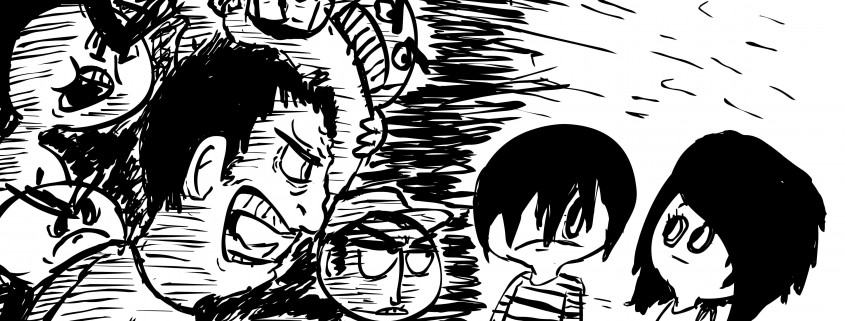Emo Cultura en México
We live in a world where trends, fashion, music and popular culture are constantly changing. When you’re living in the U.S. it’s often easy to forget how the rest of the world might react to these nuances. I’m thinking of, specifically, emo culture among youth and the problematic issues that arise when it’s adopted and observed outside of the U.S.
Emos, from what I’ve gathered, are made up of young guys and girls who listen to screamo music, wear dark clothing and makeup, and may even commit self-harm. While there are certainly large amounts of youth who still identify as emo, it begs the question: how does race fit into a culture such as this one? In particular, how do Mexicans fit into this nontraditional sphere?
In 2008, there was a violent backlash against the emo youth in México. In Querétaro, México at Plaza de Armas, there was a gathering of those opposed to the emo culture and who felt they needed to eliminate the Mexican emos by hurting and mocking them in this public demonstration.
UCLA Professor and Associate Director of the Chicano Studies Research Center, Marissa López, describes some of the reasoning behind why Mexican non-emos felt the need to make such a vicious statement. In her article, “¿Soy Emo, Y Qué? Sad Kids, Punkera Dykes and the Latin@ Public Sphere,” she explains that these particular members known as tribus urbanas felt that emos, with their culture of punk and heavy metal, were stealing Mexican culture.
See the violent backlash here: https://www.youtube.com/watch?v=5kcYt-AYRXg.
But, what poses another threat to the Mexican culture, from what I can infer, is definitely found in the ideology behind the machista.
Mexican culture is infamous and often criticized, especially by Chicana feminists, for its machismo, and pressure on Mexican males to be unfeeling and indifferent to emotion and pain. If you want a thorough definition of what a Mexican man should be, read Octavio Paz’s chapter “Mexican Masks” from his book The Labyrinth of Solitude: Life and Thought in Mexico.
Getting back to the male emos, they are the complete opposite of what would be considered México’s social construction of a “real” man. However, this not only applies to Mexican ideals, but the U.S. as well, where there are still some who hold the belief that the male is supposed to be dominant and the breadwinner of the household. But of course, let’s not forget about las mujeres.
In Mexican culture, women too have a particular part to play. There is usually not a lot of flexibility for a young woman of traditional Mexican parents to express herself. Particularly within emo culture—the dark makeup, gothic clothing, and uneven hairstyles—are all certainly things that would be frowned upon. In her article, López offers a wonderful analysis of an emo Mexican woman from the novel Dahlia Season by Myriam Gurba, and her struggle to be accepted by a society that doesn’t take kindly to her emo-ness.
Although literature, style, and cultural values play a large part in trying to understand the emo culture, one of the best-known aspects of the emo culture is its music, particularly tunes by The Smiths/Morrissey. The Chicano Studies Research Center held a symposium in May titled “LAT/EMO: A SYMPOSIUM ON MUSIC, MARKETS, AND LATINIDAD,” where López and other distinguished speakers addressed the issues concerning Mexican emos. There was also a special musical guest present: Jose Maldonado.
Jose Maldonado is part of a Morrissey/The Smiths tribute band called “The Sweet and Tender Hooligans,” whom perform all across the country, as well as outside (such as Mexico), and enchant their audiences with the sweet sounds of this beloved band. Interestingly, this music is widely admired by Latinos, and even better, Maldonado and his group even perform the songs in Spanish. Maldonado is just an example of how something outside the norm can eventually be widely accepted and loved by fans of all different ages, races and cultures. The Mexican emos are only one of many who are scrutinized for what they like, wear, or believe.
Although Mexican culture in particular has shown a great displeasure for the emos, it is important to appreciate those who continue to pursue the identity they want regardless of society’s expectations. If there’s one thing the México emos have taught me, and hopefully others, it’s that even among the bigger controversial groups there are smaller groups, such as this one, that suffer the same abuse and that also need to be supported and treated fairly in the world.
To check out the entire “LAT/EMO: A SYMPOSIUM ON MUSIC, MARKETS, AND LATINIDAD” symposium, the CSRC has kindly posted the video on YouTube: https://www.youtube.com/watch?v=xdZbn6DlMaw.
Be sure to check out Jose Maldonado’s acoustic performance around 2:25:26 – it was an absolute pleasure to witness. I hope you enjoy it!











Leave a Reply
Want to join the discussion?Feel free to contribute!